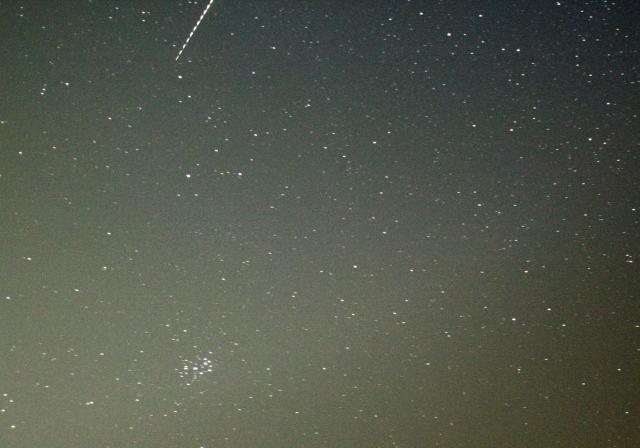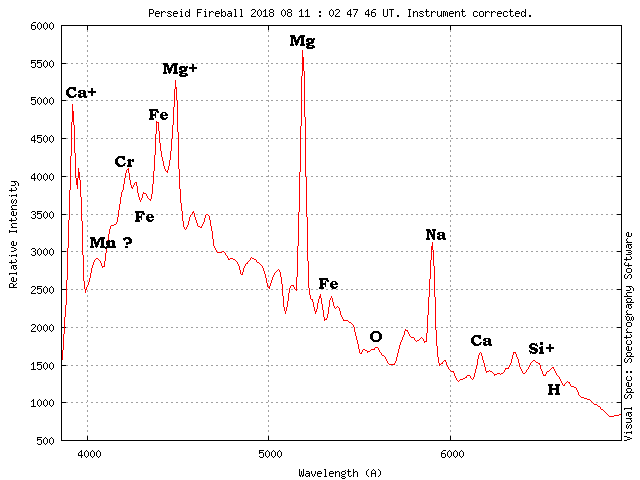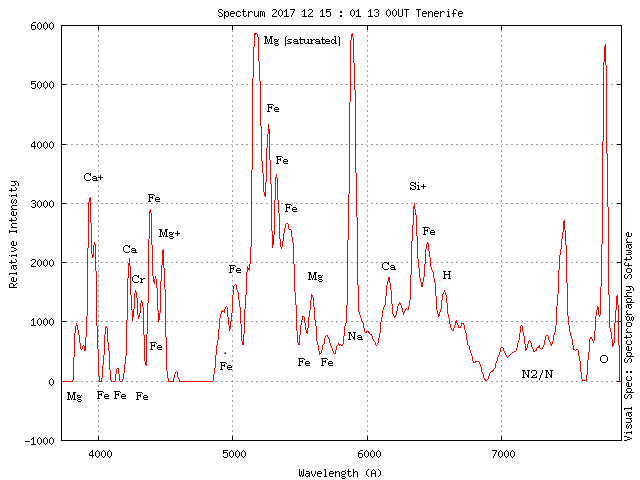Forum Replies Created
-
AuthorPosts
-
 Bill WardParticipant
Bill WardParticipantfooooooour thousand feet across….
 Bill WardParticipant
Bill WardParticipantHi,
The exposures were 27 secs at iso1600. 30mm f1.4. In short you can’t know. The chopping, in principle, is used to provide accurate meteor duration and precision astrometry allowing meteor velocity and decelerations to be measured. This in turn is used with other observations to produce better orbits. The previous owner of the mechanical system I’m trying to re-instate, the late Steve Evans, wrote a very interesting paper in the BAA journal on precision observations. One of the reasons his shutter system was designed to chop at 60 breaks/sec.
I’m having some trouble with vibrations so will need to re-evaluate my design. The advantage of the mechanical shutter is that it is working at 100% efficiency. The shutter blades completely block or not. The LCD shutters have both polarisation issues and the fact that when open are still ~30% opaque (thats ~0.6 of a stop). Any meteor needs to be that much brighter with a LCD cf mechanical.
Like everything with meteor astronomy it’s all a trade off!
cheers,
Bill.
 Bill WardParticipant
Bill WardParticipantHi,
I couldn’t find her address as I was going to do just that. Could be the Flash issue, I tried other pages and they were fine too. If you have her address it might be worth dropping her a line just in case. Feel free to reference my experience. It’s THE most important piece of software I use!!!
cheers,
Bill.
 Bill WardParticipant
Bill WardParticipantMichael,
An update… After posting I decided to check the tutorial on the Visual Spec site. There is some sort of hack or virus or something going on. My laptop security went mental. Approach with caution…!
Bill.
 Bill WardParticipant
Bill WardParticipant…and now they’re back,,,, how odd, don’t know what’s happening!!!
 Bill WardParticipant
Bill WardParticipantmmmm, there should have been a couple of pics….
Here they are now.


 Bill WardParticipant
Bill WardParticipantMichael,
It’s easy enough to do but a pain to describe….
There are tutorials on the RSpec site (looks like that’s the package your using).
Also take a look on the Visual Spec site (http://astrosurf.com/vdesnoux/) , there’s a comprehensive tutorial using Vega. That’s the technique I use. I much prefer working with Visual Spec and IRIS. They don’t have the slick interface but I like the command line method, makes you think about what your doing.
cheers,
Bill.
 Bill WardParticipant
Bill WardParticipantHi,
The 8/9 and 10/11 Aug 2018 provided some good results. 31 spectra over both nights. This is the best Perseid (so far, maybe it’ll be clear tonight… ;-))
)

Here is the instrument corrected spectrum graph.
Note: I’ve cropped the O and N lines from the atmosphere, in the near IR. I’ve also binned by 3 to smooth out the de-slanting artifacts but probably at the loss of some small lines (mostly Fe).

It’s always re-assuring to see similar results from other observers. However there are two lines (or maybe very close bands) that I have not been able to tie down. I’ve got these on lots of Perseids from the last several years. Not sure what the bumps are around the Na line…. Could be any of several but at this resolution it’s difficult to be absolutely certain.
I also got a small section of this same meteor on another system. Almost perfect dispersion too… Still to process that one.
cheers,
Bill.
 Bill WardParticipant
Bill WardParticipantAlex,
Downloaded the first paper by Steve you listed during my lunch. Interesting read. (Also glad to see my chop rates were in accordance with his determinations too…). I’ve not played with astrometrica for a LONG time. Working with DSLR images looks like it’ll be a bit of a challenge. But he’s laid down the gaunlet for a few arc sec precision to directly measure decelerations.
Ties in really nicely with the demand for high speed chopping (I take it that’s why he made the six slot shutter). This of course open up the challenge of making a 9 or 12 slot shutter for very high mechanical chop rates. The LCD’s start to show their convenience at this point.
Anyway, got plenty of things to do now to fill my staycation this summer!
You mentioned Edinburgh, will you be up for a couple of days? I’ll try and come through (by train this time) so we can finally have a few refreshments! Might even have some results should the weather cooperate for the Persieds.
cheers,
Bill.
 Bill WardParticipant
Bill WardParticipantHi,
Tested the rotating shutter at lunchtime. It’s turning at a fair clip. Chop rate is 62.5Hz. This is faster than the LCD rate on the image from the earlier post. I think a shutter with 2 or 3 blades (20.83Hz and 31.25Hz respectively) may be better for more general purpose observing. Need to locate some suitable plastic sheet and get cutting….
cheers,
Bill.
cheers,
Bill.
 Bill WardParticipant
Bill WardParticipantHi,
It’s interesting to read that the problems with astrometery are nothing new! It is probably the sole advantage of DSLR imaging over video. The precision is vastly better! Talking to Felix about the LCD shutters he tells me that this issue was one of the drivers for trying them despite their optical limitations.
I ran the LCD system I have for ~2 hours through the wee hours of Sunday morning but didn’t catch anything. Despite the near full moon and essentially twilight conditions through the night at my latitude, the DSLR images looked much better than I anticipated given the sky brightness. The only concession I made was reducing the ISO from 1600 to 800.
We’ll see how it goes.
Cheers,
Bill.
 Bill WardParticipant
Bill WardParticipantHi,
That’s great. I’ll look them up…
cheers,
Bill.
 Bill WardParticipant
Bill WardParticipantHi,
After collecting Steve Evans’ old system I gave it the once over. A few loose connections were tightened and I changed the power lead. Seems to work a treat now. Next thing is to determine the rpm and chop rate….
It’ll be interesting to compare the two methods (hopefully during the Perseids…)
Cheers,
Bill.
 Bill WardParticipant
Bill WardParticipantHi,
I’ve just sent you an email. Sounds good. See you on Saturday.
cheers,
Bill.
 Bill WardParticipant
Bill WardParticipantHi,
If you have a look at the manufacturer’s website all the figures are there. I’m using a FOSG2 (circular version).
Off the top of my head it’s the transmission that is the problem. It’s only about 37% thus you’re losing ~ a stop. A fast lens is needed. The extinction ration is 1800:1. That’s dark enough for meteor work but whether this is sufficent for other imaging I’m not sure. The meteor image shows quite a clean profile, I pleased with the result (and if I’d paid more attention to the timing diagram on the website the actual chopping rate wouldn’t have been a surprise! ;-)). I’m currently constructing a ye olde fashioned rotating shutter for some other cameras so it’ll be interesting to compare the results….
cheers,
Bill.
 Bill WardParticipant
Bill WardParticipantA rather late follow up. One of the issues that originally confused me was the duration of the meteor from video compared to the duration determined by the chops in my still. After some tests with my system and an oscilloscope there is an effective doubling of the chops due to the way the crystals in the shutter work.
In this case the function generator was producing a square wave at 20Hz (20 times per sec) HOWEVER the crystals seem to switch with every reversal of voltage so a 20Hz rate from the function generator gives 40 chops per second. What this boils down to is that the meteor was only half as long as I originally thought but now it fits much better ;-))
Further digging around reveals that driving them this way, with a pos-neg-pos-neg voltage etc signal a: makes them work properly and b: if you use, say, zero-pos-zero etc it can cause the crystal to degrade much quicker (according to the manufacturer’s bumff.)
So, beware if you use these LC shutters, they might not give you what you think they should be giving you…!
I am now confident it was the same meteor.
Cheers,
Bill.
 Bill WardParticipant
Bill WardParticipantHi,
That’s an excellent example, and indeed a long gap between the light emissions. Must have positively skipped into the atmosphere ;-))
Bill.
PS, Great to catch up with you at Newcastle. I should have taken a chance and got on the train with you rather than waiting for the “direct” later train. Ended up being 1h 30min late!, I’m glad I had driven into Glasgow as I would not have made the last train down the local line.
 Bill WardParticipant
Bill WardParticipantHi,
With so many people collecting spectrum now, that’s pretty much where we’re heading. The eminent Czeck meteor astronomer Jiri Borovicka published a paper in 2016, “Representative meteor spectra…” (sorry not sure of the full title) based on many years of his work using spectra colllected via image intensifier and recorded on video tape.
The technology has moved on and even a basic system can exceed the pros now.
The situation has gone from a few (photographic) spectra per year to several per night with video based systems!
Bigger systems with institutional funding now have hundreds of cameras running! The shower meteors are quite well established but it’s the sporadics that provide the surprises!. I’ve recorded several very interesting ones recently. With said technology the amateur is still on a par with the pros regarding sporadics.
cheers,
Bill
 Bill WardParticipant
Bill WardParticipantHi Jack/Eric,
Thanks, it’s taken a decade to get it all together and make it fairly routine. If you look through my other meteor video’s on YouTube you’ll see one of the developments over the years. Doesn’t seem like ten years, I can still remember seeing that very first really crude spectrum at 320×240 resolution and thinking this is the future. When you look at the numbers it is staggering the immense jump that has happened. HUNDREDS of hours over decades to record photographically just those few exceptionally bright fireballs producing spectra. Now, even at this time of year I get several per night (when it’s clear ;-() and dozens during meteor showers.
Now that the pros are using my type of video system they get even more since they run a lot more cameras from considerably better sites! Looking at the journals, meteor spectroscopy papers are now regular. The game is now trying to build up classifications with a large number of spectra that all look pretty similar. The first papers on this have already appeared. The differences are there but it’s a subtle game at that.
cheers,
Bill.
 Bill WardParticipant
Bill WardParticipantMonths on I’m still working through the Geminids 2017! This is a crop from the composite video image. 20171215:011300UT. (Correcting the smile is just another little challenge….)

However If you look to the left of the image the first two bright, closely spaced lines are the H and K ionised calcium lines. I am both surprised and extremely please to be getting this resolution with an objective mounted grating. Shows that a good fall of meteor across the fov (pretty much luck) can make a significant difference to the results! Considering some of the comments I’ve been exploring some new reduction strategies. Here’s a non instrument corrected spectrum with the line ID’s as best as I can tell.

If only all meteors were the same mass, traveling at the same velocity and were recorded in the zenith things would be just so much easier (but probably not as much fun!), sigh… ;-))
cheers,
Bill.
-
AuthorPosts
